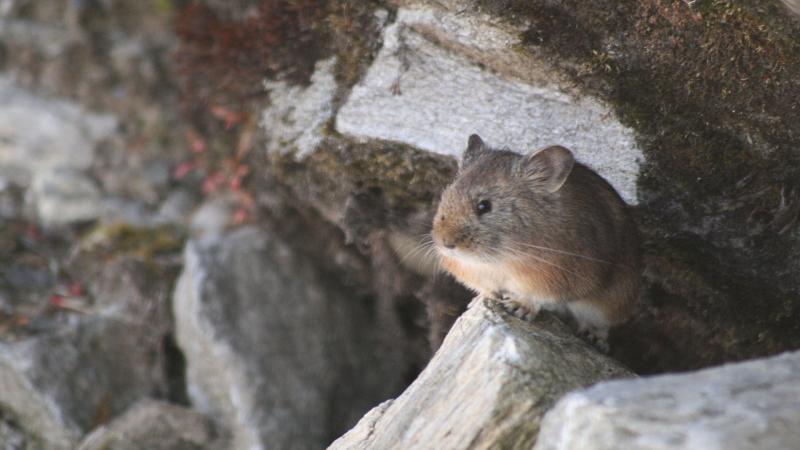
It’s getting tougher for the Royle’s pikas to survive in the Himalayas. But, these tiny, herbivores wouldn't move as they are particular about where they live. Restricted to rocky, mountainous terrains, they are now facing the wrath of rising temperatures and fluctuating environments. What would become of them in a few more decades? Can these fussy relatives of the rabbit find new homes and thrive?
A recent study by researchers from the Indian Institute of Science, Bengaluru, and the Wildlife Institute of India, Dehradun, has shown what climate change has in store for the Himalayan pikas, five decades from now. The study was published in the Journal of Regional Environmental Change and was funded by the Council for Scientific and Industrial Research (CSIR), Department of Biotechnology (DBT), IISc and the Pro-Natura Foundation, Japan. The findings of the study help to plan conservation strategies for the Royale's pikas and other mammals found in the alpine habitat.
"Pikas are a unique example of how ecologically important species are vulnerable to extinction," explains Dr Sabuj Bhattacharyya from IISc, who is the lead author of the study. "This is primarily because of climate change, rather than other biotic pressures like predators or anthropogenic activities," he adds.
Unlike their American cousins, there has been little research on the impacts of climate change on the Himalayan pikas and their distribution patterns.
Bringing insights from his previous studies, Dr Bhatacharyya says, "Royle's pika are sensitive to changes in snow cover and temperatures like the American pikas, which are known indicator species for climate change".
The Royle's pika is currently found in north-western Pakistan, Indian Himalayas, Nepal and Tibet. During field surveys, the researchers encountered pikas in four distinct rocky habitats—alpine meadows, forests, stone walls or similar human-made structures and near glaciers. They gathered locations of where the Royle's pikas were present from 1980 to understand what has shaped the current pika distribution. As a next step, they constructed a model to include climatic and geographic variables to extrapolate suitable habitats for the Royle's pikas in 2010, 2050 and 2070.
The study also accounted for varying emission levels of greenhouse gases projected for the next few decades. These gases accelerate climate change.
"It has been predicted that by 2050 and 2070, there would be a significant change in climatic regime", points out Dr Bhattacharyya.
The results portray a gloomy future for the pikas with a significant loss of their habitat at the rate of 102 sq km per year in the near future! That's equivalent to a seventh of Bengaluru's area. The study found that by 2010, only a total of 35,353 sq km was a suitable habitat to the pikas, as compared to their presence back in 1980. This loss was especially noticeable in non-protected areas and low-elevation regions of the Himalayas.
But protected areas would not do too well, either, predicts the study. Those in the north-western regions, like Dachigam National Park, and the eastern regions like Dibang Wildlife Sanctuary, might lose 50 to 100% of the available pika habitats by the year 2070. In comparison, a handful of protected areas, such as the Kedarnath Wildlife Sanctuary and the Nanda Devi Biosphere Reserve, could gain additional suitable habitats for the pikas by 2050 and 2070.
The researchers found that snow-cover and rainfall were the most significant predictors of the distribution of pikas. Snow cover in the coldest months acts as thermal insulation for the tiny mammals. Like rainfall, snow cover also influences the growth of vegetation in alpine areas – providing the herbivorous mammals with nutrition for survival. In comparison, geographical features like the ruggedness of the landscape impacted the presence of pikas only at a local level.
Connectivity between habitats played an essential role as it could predict how pikas will adapt to changing environments. Since pikas are most active during the coldest times of the day and tend to slow down as the temperatures rise, increasing temperatures decreased their available habitats.
The biodiverse Himalayas are incredibly vulnerable to the vagaries of the climate, and we are slowly beginning to see their effects.
"This region lacks long-term research to understand alpine species that are already facing the brunt of climate change," rues Dr Bhattacharya.
Ecological niche models, such as the one used in this study, offer an opportunity to simulate the relationships between the environment and distribution of animals here in the future. The researchers suggest looking at the effects of climate change through the eyes of the pikas.
"It would be interesting to know if we can monitor the pika population as an indicator species to understand the speed and magnitude of climate change in the Himalayas," concludes Dr Bhattacharya.
This article has been run past the researchers, whose work is covered, to ensure accuracy.






